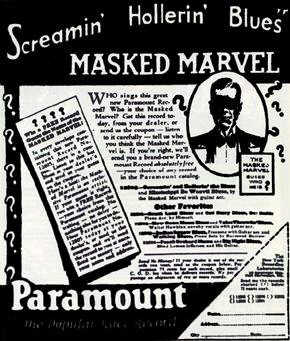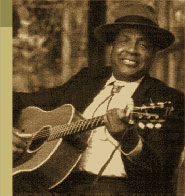 Sound
Clips Sound
Clips
 Audio
– 'Spoonful' - Charley Patton (1929) Audio
– 'Spoonful' - Charley Patton (1929)
 Audio
– For writer Francis Davis, Charley Patton was defined precisely
by his mysteriousness -- not that there aren't some interesting stories.
Audio
– For writer Francis Davis, Charley Patton was defined precisely
by his mysteriousness -- not that there aren't some interesting stories.
 Audio
– Musican Honeyboy Edwards recalls that whiskey and dancing were
two crucial ingredients that flavored the blues
Audio
– Musican Honeyboy Edwards recalls that whiskey and dancing were
two crucial ingredients that flavored the blues
 Audio
– Guitarist Corey Harris plays "Roki"
Audio
– Guitarist Corey Harris plays "Roki"
 Audio
– For Honeyboy Edwards, learning how to ride freight trains helped
spread the blues
Audio
– For Honeyboy Edwards, learning how to ride freight trains helped
spread the blues
 Listen
to Part 5 Listen
to Part 5
Photo:
Early Charley Patton (aka the Masked Marvel) promotional materials
Though musicologists can define
“the blues” narrowly in terms of chord structures and lyric strategies
originating in West Africa, audiences originally heard the music
in a far more general way: it was simply the music of the rural
south, notably the Mississippi Delta. Black and white musicians
shared the same repertoire and thought of themselves as “songsters”
rather than “blues musicians.” The notion of blues as a separate
genre arose during the black migration from the countryside to urban
areas in the l920’s and the simultaneous development of the recording
industry. “Blues” became a code word for a record designed
to sell to black listeners. Blues also came to be associated with migration
and wandering. It’s no accident that WC Handy’s tale of “discovering”
the blues takes place in a train station.
For transplanted blacks in
cities, blues was the music of home -- in the same way polkas were
the sound of the homeland for Polish immigrants. When blacks began to
migrate north the music traveled with them. Performers like Muddy
Waters began to use amplifiers and electric guitars, but the blues
always referred back to the rural south. Traditional styles could
be heard there until the late 1940’s when radio became the major
source of music. At the same time the songsters like Leadbelly were
putting their own stamp on the music.
But even as it sang of home,
it was embracing change — consorting with other musical styles,
and its Sunday sister Gospel. In Memphis, at the crossroads of the
rural south and the Mississippi River, the urban children of the blues
would take the music world under the names of rock and soul.
Today in isolated areas of
the south, traditional blues is still contemporary music. Ardent
acolytes have nurtured the flame with magazines and small record labels.
And in periodic revivals and enthusiastic festivals, fans around
the world can immerse themselves in that deep well of blues. In
spite of the disappearance of the “folk,” blues has survived to
become a sort of universal folk music
Humanities Themes:
· African influence on American music
· Migrations, urban dislocation, symbols of home
· Migrations – effect on the music and black culture
· The symbolic role of the train in blues music.
· How the recording industry popularized- and influenced-the
blues.
· The clear differences in first blues recording and all prior
recorded repertoire.
· The Myth of Robert Johnson: the larger-than-life-nature of
blues artists.
· WC Handy and the mythical origins of the blues
· Memphis and Chicago: how the mixing pot of cities transformed
the blues.
· Development of urban blues as step away from painful memory
even as it is embraced.
· Blues appeal to European and world audiences – elements
of universal (or ‘classical’) folk music.
Storyline:
Musicologists trace the origin
of the blues to West Africa. They define the music in terms of chord
and lyric structure. In a more general sense, it’s just the music
of the rural South. Its rise to popularity is, ironically, a by-product
of black migration to urban centers like Memphis in the early part
of the 20th century.
Like Bessie Smith, Ma Rainey,
and other popular black musicians, W C Handy performed in a variety
of styles, not just blues. He claimed to have “discovered” the blues
while waiting at a train station in Mississippi: the singer was
poor and rural, and the lyrics (which Handy found unintelligible at
first) referred to train routes. No doubt the story is apocryphal, but
it sets out the myth of the blues singer as a wandering minstrel
from the Mississippi delta.
The record industry, emboldened
by the success of a few black songsters, began to search out “the
real thing.” “Blind Lemon” Jefferson had no fixed address. Yet Paramount
Records took him from playing country picnics and house parties
and made him a star. Itinerant, disreputable and dangerous Charlie
Patton had flying fingers and a soulful style that made him a prototype
of the Delta bluesman. Huddie Ledbetter was almost as famous for
his life, which included time in penitentiary as for his music.
Robert Johnson, with his aura of mystery and demonic possession,
added the finishing touch to the archetype.
The audiences that consumed this music via
phonograph, radio, and jukebox were increasingly urban -- and increasingly
northern, as blacks began to migrate to cities like Chicago. Could the
blues continue to exist as “city” music?
Interview subjects:
Sam Charters,
veteran field recordist and author of “The Country Blues”
Corey Harris,
a young African American musician and folklorist who has studied music
in Mali, Cameroon, and the Mississippi Delta.
James Horton,
anthropologist, who can look at the sources of urban migration and patterns
of life and culture of the newly urbanized communities.
Robert McElvaine,
sociologist who can look at migration’s influence on music.
Kip Lornell, anthropologist
and folklorist, author of “The Life and Legends of Leadbelly”
and “The Musics of Multicultural America.”
Historic Recordings:
Examples of Traditional West
African music
Folkways Records (Smithsonian
Institution)
John & Alan Lomax recordings
of Southern field hand hollers
WC Handy’s “St. Louis Blues”
performed in a variety of styles
Blind Lemon Jefferson’s “That
Black Snake Moan”
Charley Patton’s “Pony Blues”
or “High Water Everywhere”
Robert Johnson’s “Cross Roads
Blues.”
Archival sound – Robert Johnson
session -- collection of Institute of Texan Cultures
|


 Sound
Clips
Sound
Clips